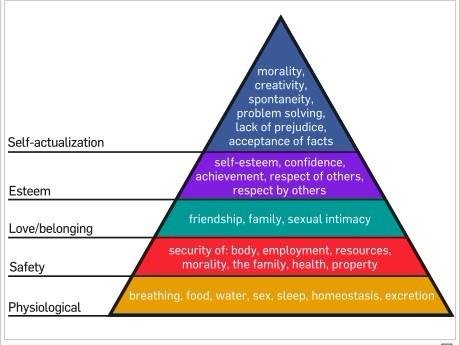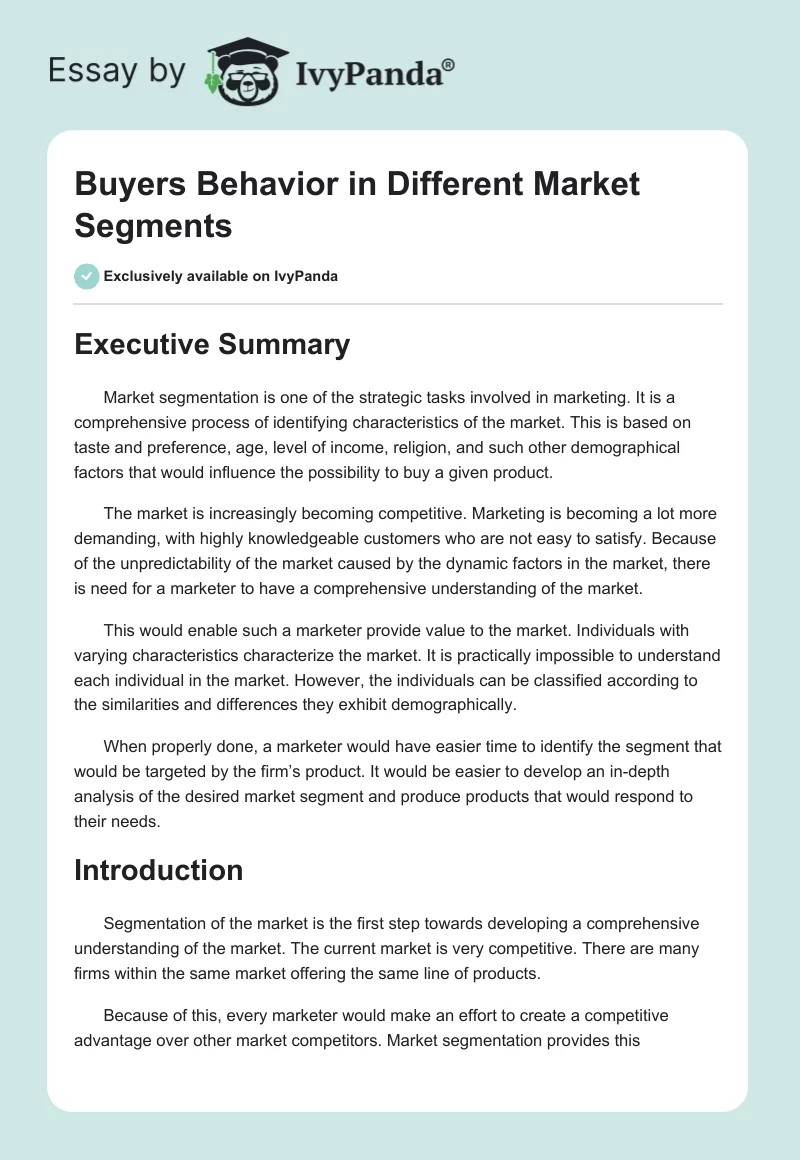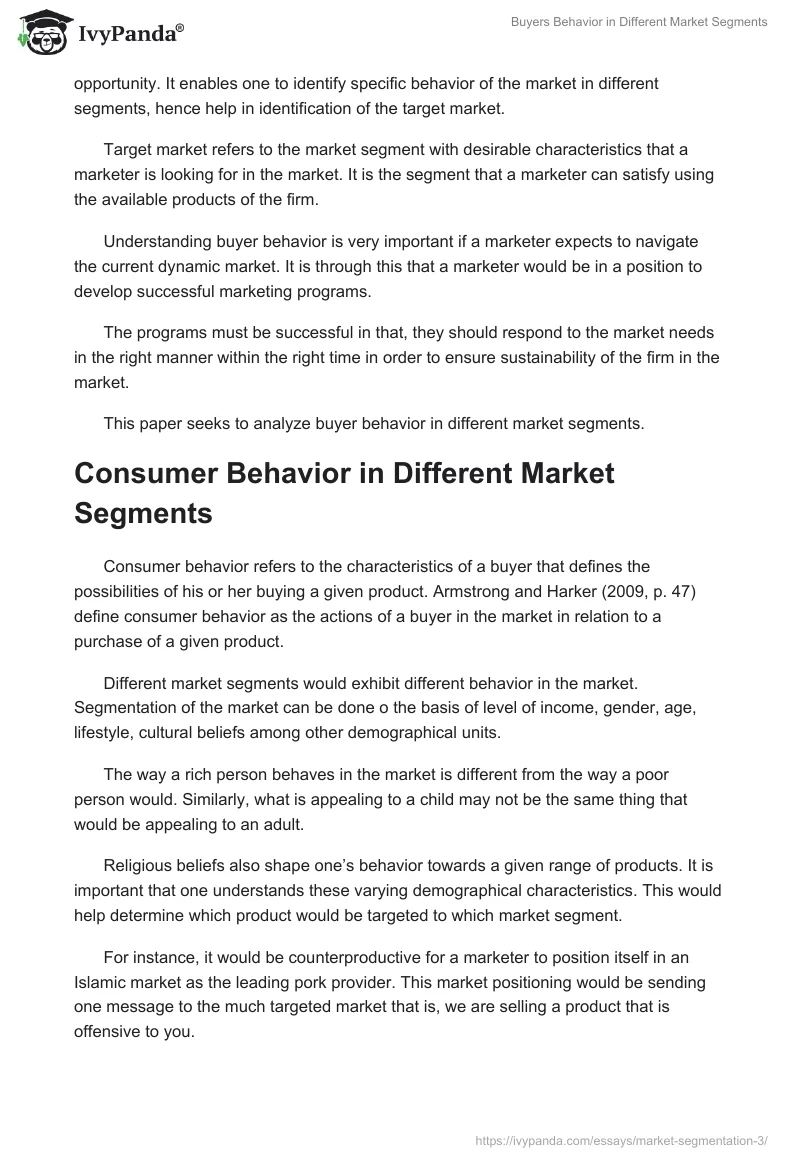Executive Summary
Market segmentation is one of the strategic tasks involved in marketing. It is a comprehensive process of identifying characteristics of the market. This is based on taste and preference, age, level of income, religion, and such other demographical factors that would influence the possibility to buy a given product.
The market is increasingly becoming competitive. Marketing is becoming a lot more demanding, with highly knowledgeable customers who are not easy to satisfy. Because of the unpredictability of the market caused by the dynamic factors in the market, there is need for a marketer to have a comprehensive understanding of the market.
This would enable such a marketer provide value to the market. Individuals with varying characteristics characterize the market. It is practically impossible to understand each individual in the market. However, the individuals can be classified according to the similarities and differences they exhibit demographically.
When properly done, a marketer would have easier time to identify the segment that would be targeted by the firm’s product. It would be easier to develop an in-depth analysis of the desired market segment and produce products that would respond to their needs.
Introduction
Segmentation of the market is the first step towards developing a comprehensive understanding of the market. The current market is very competitive. There are many firms within the same market offering the same line of products.
Because of this, every marketer would make an effort to create a competitive advantage over other market competitors. Market segmentation provides this opportunity. It enables one to identify specific behavior of the market in different segments, hence help in identification of the target market.
Target market refers to the market segment with desirable characteristics that a marketer is looking for in the market. It is the segment that a marketer can satisfy using the available products of the firm.
Understanding buyer behavior is very important if a marketer expects to navigate the current dynamic market. It is through this that a marketer would be in a position to develop successful marketing programs.
The programs must be successful in that, they should respond to the market needs in the right manner within the right time in order to ensure sustainability of the firm in the market.
This paper seeks to analyze buyer behavior in different market segments.
Consumer Behavior in Different Market Segments
Consumer behavior refers to the characteristics of a buyer that defines the possibilities of his or her buying a given product. Armstrong and Harker (2009, p. 47) define consumer behavior as the actions of a buyer in the market in relation to a purchase of a given product.
Different market segments would exhibit different behavior in the market. Segmentation of the market can be done o the basis of level of income, gender, age, lifestyle, cultural beliefs among other demographical units.
The way a rich person behaves in the market is different from the way a poor person would. Similarly, what is appealing to a child may not be the same thing that would be appealing to an adult.
Religious beliefs also shape one’s behavior towards a given range of products. It is important that one understands these varying demographical characteristics. This would help determine which product would be targeted to which market segment.
For instance, it would be counterproductive for a marketer to position itself in an Islamic market as the leading pork provider. This market positioning would be sending one message to the much targeted market that is, we are selling a product that is offensive to you.
They will not only fail to buy the product, but develop a repulsive attitude towards the firm. They will view all the products of the firm as offensive. To continue surviving in this market, such a firm would not only need to change the products they offer, but also a complete overhaul their system by changing all their identification in the market. They need to take a new shape in this market.
Every marketer would want to avoid such an embarrassing situation like the one above. Similarly, a marketer should be in a position to determine the driving force of every market segment. The rich are driven by the desire for quality.
They do not mind the price as long as the product is of the right quality. They also spend lesser time shopping for their products. On the other hand, a poor customer gives quantity and price a priority. The item to be bought should be cheap and of large quantity.
Such a customer would also spend a lot of time shopping for a cheap product with a higher quantity (Blackwell & Miniard 2006, p. 64).
A marketer would therefore tailor make the products for the rich to reflect quality, while that for the poor to reflect quantity. This is because the two groups of individuals exhibit different needs in life. The Maslow’s hierarchy of needs would be of help in elaborating this point.
The Maslow’s Hierarchy of Needs

What motivates individuals to buy certain brands and leave others? Notably, Maslow theory of hierarchy of needs can evidently explain what would have pushed the consumer to purchase certain brands in the market. Maslow discussed issues relating to needs and he explained clearly that individuals are majorly influenced by different needs in whichever environment they are exposed to.
However, he emphasized that individuals will initially fulfill their basic needs before fulfilling the secondary needs. His theory states that physiological needs are the primary needs that any human being will tend to satisfy before satisfying other things.
These will include food, housing and clothing. Physiological needs are followed by security needs, which majorly consider safety and security as important needs in an individual’s life (Woods & West 2010, p. 63).
This includes job safety as well security in various places. Social needs appear at the third level, which consider the need to love and to be loved. It seeks companionship and friendship at work place and outside.
Esteem needs are only sought at higher level after other fulfillments are achieved. This might include the need to be respected, as well as achieving recognition in the society. According to Maslow, self-actualization is the uppermost level needs. It entails securing a recognizable rank or job position in work place and in society.
It as well compels one to achieve the best in his area of specialization. Maslow’s hierarchy of needs is so crucial for marketers in order to remain competitive in the market. It assists marketers to identify the type of market dominated by certain people, who portray almost similar characteristics.
Residents who seek esteem needs as well as self-actualization needs as opposed to those struggling for security and psychological needs may inhabit a certain region (Evans 2010, p. 86). Features that are commonly witnessed in the higher end market will characterize such regions.
Therefore, individuals will find it relevant to pursue strategies that focus on value and quality of products rather than cost-leadership strategy. For instance, a marketer will target a market by offering products at a premium price.
On the other hand, a marketer will probably approach lower end market, which still struggles with physiological needs and security needs using cost-leadership strategy and will rarely put much focus on the quality of products (Beardwell & Claydon 2007, p. 56).
Depending on an individual’s class within the hierarchy, there would be different needs at every stage in life. A marketer needs to understand each stage and how it relates to the available products of the firm. This would make it easier to reach out for the target segment.
How individuals interact with the marketing mix
The marketing mix inputs refer to the four Ps commonly featuring in the marketing section. The four Ps include price, place, promotion and product. Interaction between the four marketing mix and the consumer normally determines the buyers’ choice of alternatives available at market as regards to the process of purchasing.
However, an individual choice would also depend on a number of personal aspects such as culture, attitude, educational level and individual’s perception (Giddens 2009, p. 67). Purchasing decisions made at the market include the choice of the product, location, brand, among other choices.
Interaction of individual characteristics and that of the marketing mix will have a considerable impact on choices made by consumers. The price of a product is very sensitive with respect to making a profit in any market segment.
Price is crucial as it helps marketers to set low charges for lower end market and setting premium charges for higher end market. Individual’s perception and culture also play a major role in influencing consumer’s choice. Many firms in various markets are used to providing the same marketing mix to different individuals and markets.
However, it would be wise to tailor the marketing mix and provide it to the specific market segment. This has seen a number of firms perform well in a number of markets. For instance, Coca Cola Company is manufacturing some new soft drinks such as Schweppes, which mostly target youths.
Market segmentation
A market can be segmented based on various factors such as the region, demographic factors, among other ways. However, when segmenting a market, the it should prove to be measurable, accessible in terms of distribution and communication and durable that is, not very dynamic (Gorchels & West 2004, p. 83).
In addition, the market should be different in responding to the marketing mix and be substantial enough to be lucrative. Notably, consumer markets are segmented differently from the industrial markets.
Specifically, a business would tend to identify a unique factor such as age, which is able to differentiate one market from the other. However, consumer markets would commonly be divided based on four categories. These would include the following.
Geographic segmentation
Market fragmentation could be done physically based on some aspects, including the area, populace growth rate, density, environment among other variables. Rarely do marketers use the climate to segment the market. However, most businesspersons use various factors associated with the population to establish substantial markets for tailored products.
Demographic segmentation
Demographic factors are also used in differentiating markets in relation to certain tailored markets. Variables related to demography include age, education, family status, education, income, ethnicity, income among others. A variable such as income has enabled marketers to distinguish the high-end market from the lower end market.
Psychographic segmentation
The psychographic segmentation is more complex and needs critical analysis to differentiate the market on such basis. As regards to psychographic factors, the market is fragmented based on three factors that is, individual’s feelings, principles and ways of life. Lifestyles and values of certain of people will determine the type of the brand and price to be offered in such a market.
Behavioral segmentation
This is one of the aspects considered in segmenting a market and is majorly based on variables such as price sensitivity, benefits, brand loyalty, patterns, as well usage rate (Kurtz 2008, p. 112).
A successful marketing program and market segmentation
Coming up with a successful marketing program begins with tailoring the four marketing Ps that is price, product, place and promotion. A successful marketing program means designing a suitable product, which is related to charging the right price and using an effective promotion model in the right market or place for the product to sell in large volumes.
This would lead to exceptional profits relative to other brands in the market. Frequently, businesspersons will modify their marketing mix to suit a certain market segment (Kotler 2003, p. 57). Marketers have identified that companies will find it difficult to penetrate a specific market due to lack of compatibility between the marketing mix and the market segment.
For instance, to penetrate in a market, which has inhabitants with low income, it would call for a reduction of the brand price through various means in order to benefit from high volume of sales that is majorly attributable to the large market.
Poor marketing program arises because of poor restructuring of the marketing mix. For instance, consider a marketer who ends up selling prestigious products in lower end market or market inhabited by majority of residents whose income is low.
This would automatically lead to failure of a firm. Again, it would be ineffective to use television advertisements, with complex language in a rural region where majority of residents have low level of education.
Designing an excellent marketing program needs a critical and in-depth analysis of market in order to come up with the right marketing mix. It involves identifying the consumption pattern of consumers and analyzing the buying behavior. This would help find out an average level of income (Klein 2009, p. 92).
Such information would further help in identifying the right product and price for a given market. An effective promotion would also be identified. For instance, it would be prudent to use premium price in a market where a good number of residents are educated and earn a handsome salary.
A good marketer will also learn to penetrate a low-income market with a cost leadership strategy. Cost leadership strategy is concerned with lowering the price of a brand while aiming at volume sales that would boost the profitability of a firm.
Conclusion
In any market, it is pertinent to undertake an analysis of market factors such as the consumption pattern, level of income, lifestyle, educational level, among other market features before deciding on the right marketing mix that would help a business perform exceptionally in the market.
However, it has turned out that identifying a market segment has been a driving force for great performers in major markets. In identifying a market, which one would wish to deal with, one is required to categorize any market in accordance to a number of factors. These factors include geographical aspects, demographic factors, behavior and psychographic characteristics.
An individual or a firm may attempt to supply a certain product at a specific price through support of promotion. For instance, Puma, one of the vibrant companies dealing with athletic shoes and other brands, has remained strong in the market because of its level of specialization in athletic products that has earned it a good reputation.
Several scholars identified four Ps as the main tool with which a firm can target a market. However, in the recent times, some scholars have gone further to include additional four Ps. This has resulted to eight Ps instead of the initial four Ps.
The four additional Ps include packaging, process, people and physical environment, such as the mood and tone of the environment.
List of References
Armstrong, G & Harker, M 2009, Marketing: An introduction, Prentice Hall, New Jersey.
Beardwell, J & Claydon, T 2007, Human Resource Management: A Contemporary Approach, Prentice Hall, New York.
Blackwell, D & Miniard, W 2006, Consumer Behavior, South Western, Thompsons.
Evans, D 2010, Social Media Marketing, an Hour a Day, Wiley Publishing, Indianapolis.
Giddens, A 2009, The consequences of modernity, Blackwell Publishers, Malden.
Gorchels, L & West, C 2004, The Manager’s Guide to Distribution Channels, McGraw-Hill, New York.
Klein, H 2009, Customer Engagement Strategies, the three keys to engaging C-suite executives, Cengage Learning, New York.
Kotler, P 2003, Marketing Insights from A-Z: 80 Concepts for Every Manager, John Wiley and Sons, New York.
Kurtz, D 2008, Contemporary Marketing: Designing Customer Oriented marketing Strategy, Cengage Learning, New York.
Woods, S & West, M 2010, Organizational Culture, Climate and Change, Cengage learning, New York.


